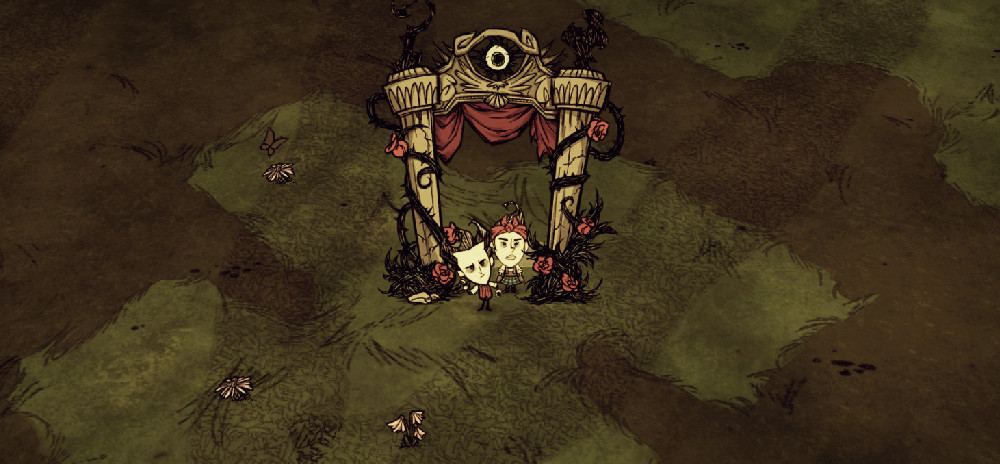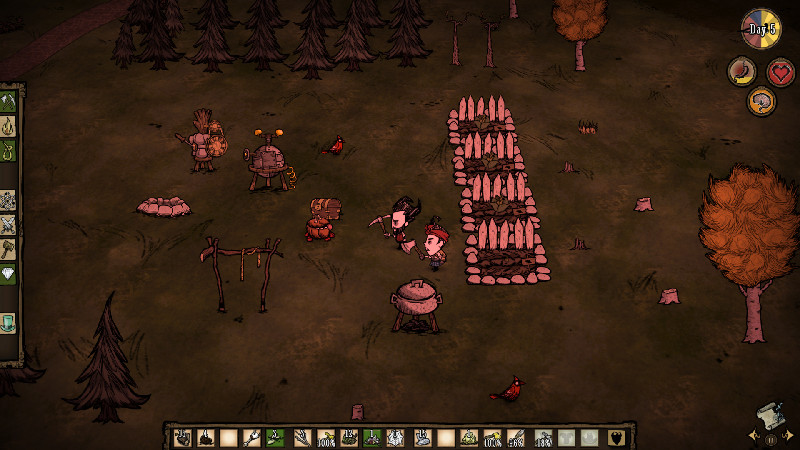“Let me see what you got.”
“So the plan was for me to gather enough stones, manure, and grass, to create two more improved farms, plus gather any scarce food I could find on the way so we can cook our monster meat.
“Yup.”
“So, on the way there, I got attacked by a group of vicious frogs, I dropped my pickaxe, and couldn’t go back for it, I got too low on health and I did not want to risk going so close to the spider webs, so I went around, but then it became dusk so I had to head home, once again, on the long way, because I didn’t even find any flowers to heal up on. Now I’m freezing, my sanity is very low, and I need some food.”
“OK…”
“On the plus side, I found this twig. Which might distract the approaching hounds.”
Don’t Starve Together is a survival – crafting – exploration game, published in 2016, as a multiplayer expansion / sequel / mod to the original Don’t Starve game. You and your partner(s) arrive in a mysterious world through a mysterious portal, you explore, gather resources, craft items, try to survive, and most importantly, as the title suggests, you try not to starve. There is no preset goal of the game, you just try to survive for as long as possible.

When we first started up the game, we didn’t do any preparation, tried to rely solely on our gamer instincts. So we started running around, scavenging for scraps, were very happy with ourselves. Look, a flower, oh, how cute, a twig, nice, this will be useful, oh my god, a carrot, what are the odds. And then it became slightly darker, we were in the time period later revealed to be called dusk, which is apparently about 25% of the day in this strange world. We were pretty sure we were supposed to do something with fire as the night came, but was not sure when to start, so we figured we would wait until it’s dark. And then in a second, it became pitch black, and all we could see was red flashes and blood and our rather rapidly diminishing health bars and menacing, glowing eyes. Then we died and the game ended.
Lesson learned, you need fire. In the next game, we focused on getting a fire going, and then we decided the most efficient way is probably to have a permanent campsite. So we did that, started venturing out, exploring, getting better tools. We ran into a couple of monstery types, but figured they were not particularly aggressive, and they are easy to avoid, so we should concentrate on getting our engine going, and postpone weapons for now. We had a peaceful, productive time. Until about day five, when a pack of vicious hounds arrived, and tore us to pieces, however hard we hit them with our shovels.
Lesson learned, you need weapons. At this point we were pretty good at the scavenging stuff so we did not lose any efficiency, beat back the dogs. And then we noticed how the previously so abundant food source became scarce, and how we ignored the cooking pot crafting option.
Lesson learned, you need a more efficient food system. Then it was winter and we froze to death.
Lesson learned, you are not supposed to freeze to death.
And so on and so forth. You learn lessons and apply them to your next playthrough, until you figure you sufficiently mastered the game. At which point you supposedly quit the game, satisfied with yourself (no real goal, remember?).
The Good
The game is complex and intriguing. This complexity alone, seeing the structure in the dozens of different crafting materials and more than a hundred crafting recipes (and another hundred actual recipes intended to solve the non-starving aspect) would result in a fair degree of challenge.
Add the survival elements, and the game becomes a gargantuan puzzle. It’s just a shame I’m not sure we have all the pieces to solve it… For some reason, we kept coming back for more, we started reading wiki guides about tiny statistical details of resources that would give us the definitive edge. It is satisfying to build up your tiny little homestead and arrive home at the end of a long day of scavenging and have a rest in the crafting menus next to the fire.

The game is full of little surprises and random elements. I see you burnt down a bunch of trees, well, too bad. I see you murdered some innocent rabbits to eat, well, too bad. It’s a pleasure to experience these surprises and to make the hostile world that tiny bit more predictable for your next playthrough. (Because surprise usually means death.)
One more thing to praise about the game is the aesthetics, it is unique and artistic and the simple animation and sprite structure works very well with the bleak and unforgiving gameworld. Everything is 2D and looks like it’s been cut from paper, or in some cases, cut from paper and then drawn upon, which supports the otherworldy, eerie feeling in the game, the involuntary belief that something is not right on the basic level. Oh, and music’s good too.
The Bad
That’s about it as far as praise goes. This game has a lot of mistakes that makes it impossible for me to love it, and it’s still questionable if I like it at all.
The worst aspect by far is the combat. It’s way too wonky, does not feel responsive, and for a game where life and death and restarting your whole game depends on a single hit, that is unforgivable. Every single time I’m wondering if I hit the monster, if that was an actual hit, or did I just swing my weapon accidentally, did it connect, if not, why not. It’s not supposed to be a complex battle system, every hit is supposed to have a fix amount of damage, but I keep counting and cross-referencing with the wiki stats, and something does not feel right. Maybe I’m supposed to play with a controller, but who would play a game with 15 different stuff you need to quickly click on any point with a controller is beyond me.
I mentioned the learning structure of the game and how the challenge lies in unpredictable obstacles that instakill you and then incorporating them in your strategy. Well, that’s fine in the first couple of days, but after day 20, it simply becomes frustrating, slipping up on one tiny thing, that you won’t even definitely encounter in the next playthrough.
I also mentioned how building up your base is satisfying. Well, it is, to some extent, but I never really felt like our engine kicked off. We never became powerful. Which is fine, I get it, it’s a dark and gritty world, fine, but I’m talking near zero progress. The most painful area for me was the defense and weapon system. For a good chunk of the game, the best weapon is going to be the starting spear, the best armor is the log suit, and the best helmet is the pig helmet, but they are not enough to fend off the next level of hounds? So you are supposed to run around until they accidentally bump into something else? I don’t like that at all, it’s not fun on any level. If I want to feel so powerless, I won’t play a cute and simple indie crafting game.
There is also the lack of actual goals in the game. Sure, survive as long as you can, and then you have the chance to boast on forums. My own goals in the game were usually to see one more thing, or craft one more item, but honestly they usually felt kind of lackluster.
I also didn’t like how there was no lore in the game whatsoever. I had a constant feeling that I came late to a party and I was supposed to know something. This is a separate game I bought and all I got was, well, nothing, not even references to the original. There is no clever lurking lore in the background, or in item description, so even if you didn’t pay attention, you would get the sense of something lurking beneath the canopy of the world (a la Dark Souls), there is nothing. There are trees, you can cut them, and then there are frogs and they gut you and eat you. You can search for stuff online, watch videos on youtube, but in my humble opinion that kills immersion faster than anything.
The Co-Op
So there we go, a really difficult, complex game, with a number of issues. How does it hold up as a co-operative game?
On a macro level, it is definitely there, you have to carefully discuss who does what at the beginning of every day, one person’s mistake could ruin the whole plan. You also build your base together, everything is common property, except the items you have with yourself. However, most of the game, you are actually separated, because it’s simply not efficient to go together, unless you attack a large monster or anything like that. Which is fine, it’s still fun to discuss your adventures at the end of the day, while preparing for the next one.
The co-operation also has a nice, emotional, self-sacrificing touch, like giving someone food at the last second while watching your own hunger level grow, or saving them with a healing gland, sacrificing your own life points.

However, there’s not much specialization, you don’t really feel like you are supplementing each other, and one person gets very good in one thing, while the other will excel at something else. It’s all about the items and resources you have.
The Recommendation
That’s Don’t Starve Together in a nutshell. An interesting art piece, an enjoyable co-op experience, an unforgiving and unpredictable ride across the haunted forest. I have a hard time recommending the game, or saying that you should not try it. Maybe the best course of action would be one that seems to be the basic philosophy of the game designers: poke it a bit, and see what happens.
Info
| Release Year | 2016 |
| Genre | Crafting, Survival |
| Difficulty | Extreme |
| Number of Players | 1 to 6 |
| Length | Until you get bored |
Rating
| Overall | Mediocre |
| Story | Good |
| Co-Operation | Bad |